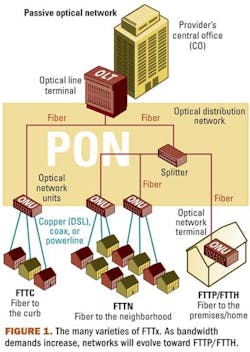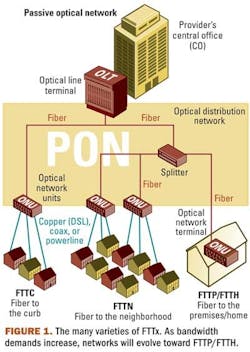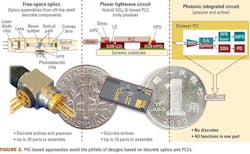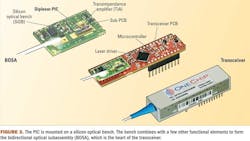PIC-based transceivers enable cost-effective 1G to 10G PON migration
By Andy Weirich
Overview
To meet the demands of both performance and cost, photonic integrated circuit (PIC) technology is the best choice for PON transceivers.
Despite the global economic challenges of the past two years, robust growth continues in the deployment of fiber-to-the-home/building (FTTH/B) network technologies.
Displaced by the rise of next-generation FTTH/B access technologies, traditional DSL technologies will saturate at around 320 million lines in the residential market by 2014, with FTTH/B still growing fast at over 160 million lines by the end of the same year, according to global analyst and consulting firm Ovum. In the Asia-Pacific region, FTTH/B growth will be even more pronounced, with FTTH/B connections overtaking DSL to be the leading technology in 2014. Ovum estimates that FTTH/B optical transceiver deployments will grow from $419 million at the end of 2009 to $456 million by the end of 2013. The share of overall broadband users who are connected via FTTH/B will more than double from around 8 percent in 2009 to more than 16 percent by the end of 2012.
This shift toward FTTH/B will provide the high-speed connectivity necessary to help carriers and system providers meet business and consumer demand for rich multimedia content and triple-play services. However, until recently, carriers and system providers have been challenged to reduce the cost of transceivers in optical network units (ONUs) and optical line terminals (OLTs) so that they can deploy PONs more cost-effectively and more widely. These challenges have been exacerbated by the need to plan for migration from today’s 1G PONs to the 10G PONs that are right around the corner.
Such cost barriers have now been overcome through the use of photonic integrated circuits (PICs), which leverage proven indium phosphide (InP) fabrication processes to bring together all passive and active elements in a single-chip device. PIC technology changes the game at the network edge by immediately enabling low-cost, high-volume deployment of FTTH/B, while also laying the foundation for a cost-effective migration from today’s 1G PONs to next-generation 10G PONs.
Fiber’s push toward the network edge
The invention of semiconductor lasers and detectors, low-loss optical fiber, and optical amplifiers have all fueled the rise of optical networking, extending both transmission distances and bandwidth capacity. The inherent bandwidth-over-distance limitations of transmitting in the electrical domain have already driven optical fiber throughout the core of today’s network infrastructures and into metropolitan-area networks and many campus/neighborhood networking environments. Now, PIC-based PONs will provide the next breakthrough in bringing optical networking closer to the end user.
Optical networking near the edge currently takes a variety of forms, collectively known as fiber to the X (FTTX). As shown in Figure 1, “X” can be “curb,” “neighborhood,” “home,” or “premises.” Not shown, but prevalent in China, is fiber to the building (FTTB). A variety of factors can drive evolution through these FTTX interim steps, including the providers’ current network infrastructure, existing capital investments, subscriber demographics, and/or demand projections.
However, growing bandwidth demands will inevitably push fiber closer to the end user, and eventually all varieties of FTTX will evolve to FTTH. This trend implies a reduction in the number of end users per ONU, culminating in just one. The result is a massive market for optical transceivers.
The increase in transceiver demand will require high-volume production of devices that can deliver higher speeds to end users while keeping per-user costs low. The relentless increase in future access network bandwidth demands also will mean that these FTTH implementations must be capable of migrating from 1G PONs to 10G PONs and beyond.
Technological and cost limitations of existing technologies
Until recently, the two primary methods for designing PON transceivers leveraged either discrete optics or planar lightwave circuits (PLCs). Both approaches have inherent limitations.
As the name implies, transceivers based on discrete optics comprise discrete, off-the-shelf active and passive components (also known as “bulk optics” components). Most transceivers sold today use such designs. With as many as 20 separate passive and active devices in the transceiver, both the internal interconnects and the packaging can pose significant reliability challenges. These individually assembled parts must be carefully aligned and also can fall out of alignment over time.
But the major drawback to discrete-optics designs is that they require the manual assembly of many parts, which must be hermetically packaged (typically in metal) to prevent intrusion from gases and liquids and guard against vibration and temperature-induced variations.
There is little architectural or technical differentiation among discrete-optics-based transceivers. Rather, vendors must compete on the basis of who can assemble the parts in a slightly cheaper fashion. And most of the opportunities to reduce labor costs already have been realized. Discrete-optics-based transceivers, designed for longer-range EPON, GPON, and especially 10G PON applications, are significantly more expensive because they require more costly components and alignment procedures.
In an attempt to address some of these price/performance shortcomings, PLC-based designs mount laser diodes and photodiodes on a monolithic optical “printed circuit board” containing interconnecting lightguides. However, PLC designs still require discrete active components and the assembly of as many as 10 parts. Optical alignment issues still can significantly reduce yields and add costs. Addressing alignment yield issues by using spot-size converted and “bottom firing” active optical components can also add significant costs because these are lower-volume, non-standard components.
Based on experience with FTTX deployments around the globe, it has now become clear that assembling transceivers using off-the-shelf discrete components will not achieve the low cost levels and efficient volume production capabilities needed for universal deployment of higher-performance FTTX networks. In addition, hybrid PLCs can only offer a temporary, transitional approach that still relies too much on forward-costing and the hope for assembly cost-curve benefits. Thus, the PLC approach ultimately is also destined to fall short of achieving the required cost/performance goals.
PIC-based transceivers shatter the cost/performance barrier
In contrast, the PIC approach, using an InP-based fabrication process, enables the monolithic implementation on a single chip of all the optical functions required for an FTTH ONU transceiver. This monolithic chip-level integration completely eliminates the use of discrete parts, avoids costly alignment procedures and hermetic packaging, and reduces overall size while improving reliability (Figure 2).
The InP-based fabrication process is used to create all active and passive elements—including a distributed feedback (DFB) laser, optically pre-amplified detector (OPAD), wavelength splitter, spot-size converter, and various elements of passive waveguide circuitry—which are monolithically integrated into one part. There are no discrete parts and no potential misalignment, and the PIC is inherently hermetic. PICs thereby optimize cost, performance, and reliability. The PIC-based approach is enabled by means of a select number of generic building blocks, and is suitable for outsourced wafer fabrication in commercial foundries.
Using a DFB laser provides superior transmit performance compared to Fabry-Perot lasers, making the PIC device more suitable for longer-reach and higher bit-rate applications. In addition, the integrated OPAD design provides higher gain-bandwidth performance compared to discrete-part avalanche-photodiode-based approaches. An OPAD approach also does not require a high voltage bias, thereby eliminating the costs associated with providing a high-voltage power source.
These inherent cost/performance advantages make the monolithic PIC approach a superior choice for volume deployment of 1G PONs to individual homes/premises. More importantly, the same PIC approach can be used as network infrastructures migrate to 10G PONs and beyond. In fact, today’s conventional discrete assembly and hybrid PLC approaches will encounter increasing difficulty in adapting to support tomorrow’s 10G PON requirements.
From a transceiver integration perspective, the single-chip PIC-based designs also provide excellent flexibility, including
1) optical transmit and receive on different wavelengths
2) wavelength de-multiplexing of incoming/outgoing signals, and
3) efficient displacement-tolerant coupling to standard singlemode fiber.
Because the optical signal path is entirely contained in a solid-state, monolithic InP semiconductor die, the design completely eliminates conventional free-space optical signal propagation and multiple discrete optical elements, thereby resulting in a robust and reliable optical path. In addition to offering the smallest footprint on the market, the monolithically integrated optical parts are aligned for life. The parts are highly robust as well, making them inherently resistant to vibration and other outside elements.
These inherent advantages “cascade upward” through higher-level production steps in the transceiver integration process. The chip-level integration facilitates efficient use of standard production processes, enabling maximum scalability for easily ramping up and down to meet industry demands and respond rapidly to delivery needs. The use of standard production processes also assures reliable supplies to customers at the lowest prices on the market.
As illustrated in Figure 3, the PIC is designed for automated mounting on a silicon optical bench (SiOB) using industry-standard automated assembly processes and without requiring any active alignment of the optics. The monolithic PIC device mounted on the SiOB provides the heart of the bidirectional optical subassembly (BOSA), which is then integrated with the transceiver PCB and a housing to form the complete transceiver.
Looking forward
PIC technology has already proven very effective for the implementation of reconfigurable optical add/drop multiplexer (ROADM) systems for metro and long-haul infrastructures. By leveraging these proven approaches in a highly optimized building-block approach to create monolithic PON transceivers, the PIC is now ready to transform the access network at the edge, as well.
The ongoing evolution of networking standards for FTTX continues to present planning challenges for service providers. But that doesn’t mean that they can afford to put off the opportunity that FTTH embodies for last-mile competitiveness. PIC-based PON transceivers make the deployment decision easier; they represent not only the lowest cost and smallest footprint on the market, but offer the most future-proof alternative for implementing PON-based FTTH access networks now.
In addition, the maturation of PIC-based transceiver technology has opened the door to its application in the consumer and datacom markets. For example, 10-Gbps optical communications is fast becoming the de facto standard “building block” within datacom environments and active optical cables (AOCs). Recent definitions of AOC interfaces have relied on multiples of 10-Gbps links to achieve up to 100-Gbps aggregate bitrate. In effect, these AOCs enable datacom managers to enjoy the benefits of 10-Gbps optics with the convenience of standard electrical interfaces, obviating consideration of optical budgets and fiber interfaces.
Similarly, optical communication is poised to become the technology of choice in the consumer market for delivering high-definition video and data to end users. For example, AOCs that support HDMI interfaces can effectively overcome the distance limitations of electrical HDMI cabling while maintaining the simple installation connectivity that is vital for the consumer market.
The consumer and datacom markets potentially represent a demand for hundreds of millions of ports per year. According to market research firm LightCounting LLC, for example, the AOC market will grow to $192 million by 2013, with a 38.5% CAGR.
The use of PIC-based optical transceivers within the consumer and datacom markets can offer significant synergies for the FTTH/B marketplace by helping to increase overall volumes, spur multiple production sources within the fabless design model, and further enhance the cost advantages of PIC-based designs over other technology approaches.
Andy Weirichis vice president of product line management at OneChip Photonics, Inc.
Links to more information
Lightwave Online: PICStartup Makes Good on $19.5 Million Promise
Lightwave Blog: Is PhotonicIntegration Market Disruptive?
Lightwave Online: CIR Forecasts ‘Realistic’ Market Expansion for AOCs



